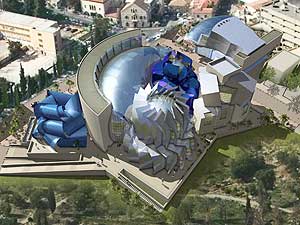No tolerance for Jerusalem's uniqueness
 Thursday, November 6, 2008 at 08:18PM
Thursday, November 6, 2008 at 08:18PM |
|
|||||
| By Esther Zandberg | |||||
| 5 November 2008 |
|||||
| http://www.haaretz.com/hasen/spages/1034344.html |
|||||
Tags: Israel News, architecture |
|||||
|
There is no need, however, to compare Jerusalem with Bilbao, or any other faraway city. Unlike Bilbao, both the earthly and the heavenly Jerusalem have been at the center of global awareness for a long time. Jerusalem's place in global tourism has been secure for centuries. The city has waxed and waned with the vagaries of time, and the present actually seems a good time for Jerusalem. In any case, no fanciful design by the latest, fleeting internationally acclaimed architect, today or in the future, will make one whit of difference. In this instance, learning from Bilbao means drawing the wrong lessons from the wrong place. It is common knowledge that Jerusalem's troubles - unlike those of Bilbao - do not stem from a lack of architectural charm, and the doldrums plaguing the city are the result of political, economic, cultural and other circumstances. Planning mistakes also play a role, the most influential of which - ignoring for a moment the inane idea of the light rail on Jaffa Road, which is another sad story - is the systematic relocation of commerce to the malls and industrial zones on the city's outskirts. That process has paralyzed economic activity in the city center, causing ruin and neglect. Equally damaging is the manner in which the city center is being presented by the city's leaders, architects and historians: as a place whose heyday has passed. Even though the situation is far from perfect, there is still tremendous potential. Many world cities yearn for this kind of urban fabric - with its beauty, ugliness and unique features. These days, architects and urban planners don't even dream about creating or planning such a combination. Thus, the premise of such arguments is deliberate bad-mouthing and brain-washing, encouraged by premeditated neglect and destruction. Soon, this will be followed by giant projects, in a place that cries out for loving and cautious treatment with precise instruments - not a bulldozer. The Museum of Tolerance is precisely that kind of giant project. Its location, in the midst of the fragile urban fabric of Nahalat Shiva, on "Cat Square," which will cease to exist, is bullish and attests to a lack of urban tolerance. Even if Gehry's collapsing and disintegrating style is appreciated by many, 30,000 square meters are a little too much. Although the museum's future content is still hazy, it will likely do nothing to strengthen the character of the neighborhood, which tries to maintain a daily routine of urban, secular, frivolous activity. Even the argument about the museum's architectural uniqueness, cited by the court, cannot defend this project. In the past decade, Gehry's style has undergone a rapid process of McDonaldization, becoming as unique as fast food in a global restaurant chain. Seeing a Gehry creation does not require a trip to Jerusalem, which has a uniqueness of its own, if only the existing and truly unique offerings were treated properly. In the same manner, the Calatrava Chords Bridge is also no reason to pilgrimage to the Holy City. If anyone expected an influx of tourists for that architectural wonder-of-the-moment, hovering over the city's entrance, they were sorely disappointed. Jerusalem can learn this lesson from Petah Tikva's Calatrava bridge, which is much more charming and pleasant than Jerusalem's, and less arrogant. But nevertheless, the bridge alone has not become a magnet drawing tourists to the coastal town. |
|||||
 APJP |
APJP |  Post a Comment |
Post a Comment | 
Reader Comments